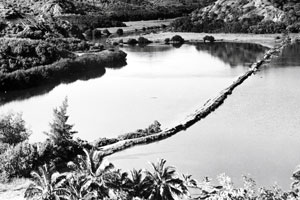|
|
|
Plantation:
Sustainability
|
|
 |
|
The ability to protect land and water resources from depletion
and still provide the materials needed by the people is called
sustainability. How did the plantation system of land management
affect the sustainability of the ahupua'a of Nawiliwili Bay. |
|
|
|
Sustainability draws from material
in the History of Forestry on Hawai'i by
Mike Robinson . |
|
|
|
In the beginning, plantations had short term objectives: getting
and clearing land for their crop, and using the existing land
and water resources to maximize their profit. The forests were
stripped for firewood to trade, and to supply the new mills.
Wild cattle added to the destruction of forests, aided by ranchers
introducing alien grasses for pasture that took over native
forest. (Robinson) |
|
 |
|
|
 |
|
As lands were cleared for fields
of sugar cane, water was diverted for irrigation. The effect
of diverting more than 50% of the stream flow may have destroyed
the native plants along the stream. (Robinson) Some maka'ainana
abandoned their lo'i because of no water, or cattle depredation.
Large irrigation projects sent water out of the watershed, never
to return. (Wilcox) |
|
|
|
Tunnel from Sugar Water
photo by D. Franzen
|
|
|
|
|
|
The conversion of lo'i into rice for export created a
shortage of poi. (Silva) |
|
 |
|
|
|
Nawiliwili rice farm below what is
Kaua'i High School today
Photo courtesy of the Kaua'i Historical Society
|
|
|
|
 |
|
Around 1880, the sugar
industry realized that the loss of forest was affecting its
water supply. This new concern for the watershed led to the
replanting of forest areas with exotic species that were not
as efficient as the native forest at sustaining the stream flow.
(Robinson) |
|
G.N. Wilcox was the first sugar planter
on Kaua'i to begin reforestation |
|
|
|
|
|
|
|
|
|
|
The sustainability of the land and
water resources at Nawiliwili Bay was affected by plantation
management. The ahupua'a were no longer viewed as a single unit.
The head was no longer connected to the tail, mauka to
makai. Decisions made on the basis of short term goals,
or profit, depleted the forest, water supply, and lifestyle
of the maka'ainana. Let's take a break from all this
serious environmental stuff and visit the harbor. |
|
|
|
|
|
|
|

